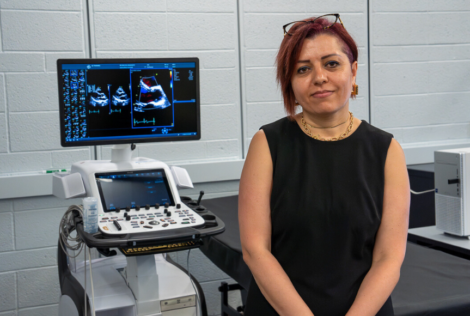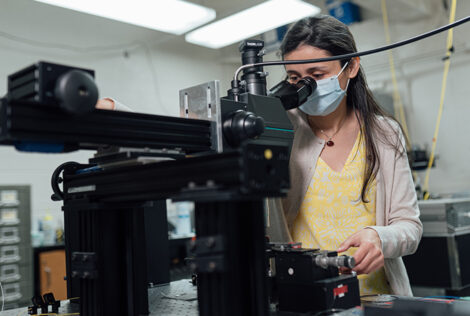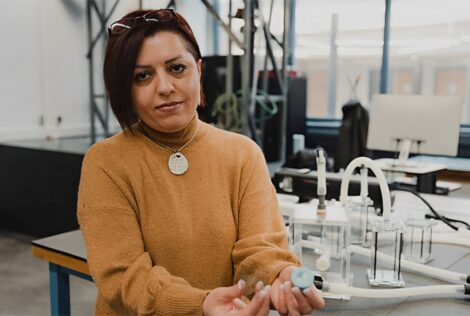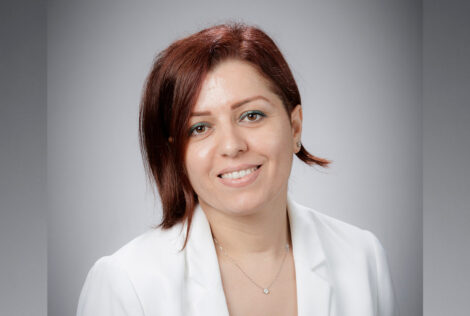
Expertise
Medical devices, medical imaging, dagnostic, intervention-predictive and intervention-optimization tools
Areas of Specialization
Research Clusters
Current status
-
Accepting graduate students
-
Associate Professor, Director of Cardiovascular Research Group and Joseph Ip Distinguished Engineering Fellow
Mechanical Engineering
-
Associate Member
Computing and Software
-
Associate Member
McMaster School of Biomedical Engineering
Other roles:
Associate Member
School of Computational Science and Engineering
Overview
Research Interests
Dr. Motamed’s research interests are in the areas of translational and basic cardiovascular mechanics. Using multidisciplinary research she tries to advance knowledge in biomechanics, fluid mechanics, solid mechanics, medical imaging and mathematical modelling. A major part of her work has been dedicated to development and validation of advanced multi-scale computational-mechanics and imaging-based algorithms for patient-specific modelling of cardiovascular system with the following objectives:
- To develop long needed quantitative diagnostic, predictive and intervention-optimization tools for cardiovascular diseases to support personalized interventions and clinical decision making
- To design, evaluate and optimize cardiovascular devices such as transcatheter heart valves and vascular stents
- To uncover causes of cardiovascular pathologies through solving complex biomedical problems
- To re-classify diseases and to establish guidelines for clinical interventions
- To lead multidisciplinary collaborative efforts to translate engineering-based findings and developments into clinical practice
- To develop monitoring tools for cardiovascular health to be integrated in future smart houses and smart vehicles
Due to the interdisciplinary nature of her research, Dr. Motamed extensively collaborates with engineers, clinical scientists, surgeons and cardiologists in Canada, USA and Europe.
Description of ongoing research
Despite advancements in surgical/interventional techniques, many cardiovascular patients do not respond favourably to treatments and their life expectancy remains reduced. Abnormal hemodynamics and biomechanics lay at the base of the initiation and progression of many cardiovascular diseases. Cardiovascular disease is the leading cause of death globally, taking more lives than all forms of cancer combined. It is expected to remain the first cause of death by 2030 in the world. Blood flow quantification can be greatly useful for accurate and early diagnosis of cardiovascular diseases. However the fluid-dynamics methods that can be used as calculating engines of the new diagnostic tools are yet to be developed. Furthermore, as most interventions intend to restore the healthy condition, the ability to predict hemodynamics and biomechanics resulting from a particular intervention has significant impacts on saving lives. Predictive methods are rare. They are extensions of diagnostic methods enabling prediction of effectiveness of interventions, allowing systematic testing for possible clinical solutions, and thus enabling personalization of interventions. The step beyond prediction is optimization of interventions to obtain the best possible outcome. Advancing computational mechanics offers a powerful means to augment clinical measurements and medical imaging to create non-invasive diagnostic, predictive and optimization tools. This is the aim behind a computational cardiovascular mechanics framework that Dr. Motamed’s lab is developing. The framework was named Poiseuille to honour the 18th-century French physicist and physiologist Jean Leonard Marie Poiseuille who provided a mathematical description for blood flow in vessels. Poiseuille is built for three folds of applications: diagnosis, prediction and intervention optimization. Poiseuille has one specific module for each of these applications and one common module that contain shared programs serving the three application modules. Currently Poiseuille is under active development. These developments present formidable mathematical and computational challenges: modeling must incorporate the motion of fluid and the motion of vessel wall, a large network of the blood vessels with complicated geometries, persistent pulse-driven changes in flow and pressure, and in some cases behavior of red blood cells. Poiseuille also provides the backbone for developing new monitoring tools for cardiovascular health to be integrated in future smart houses and smart vehicles.
Did you know?
Multiple openings for graduate students:
I am looking for graduate students with a strong background and experience in designing and building in vitro test setups, prototyping, manufacturing, data acquisition, instrumentation, programming, experimentation (e.g., particle image velocimetry).
I am looking for graduate students with a strong background in image processing or CFD, computational solid mechanics and fluid-structure interaction. Following experience and knowledge are highly favourable: lattice-Boltzmann method, finite-element method, immersed boundary method, 3-D model reconstruction using serial images, image processing algorithms, Fortran, C, and Python programming.
If interested, please send me an email (motamedz@mcmaster.ca) summarizing your education, background and interests along with your CV and transcripts.
Dr. Motamed directs Cardiovascular Research Group and is an Associate Professor with the Department of Mechanical Engineering at McMaster University. She holds associate faculty memberships in the Department of Computing and Software, in the School of Biomedical Engineering, and in the School of Computational Science and Engineering. She is a member of the Thrombosis & Atherosclerosis Research Institute (TaARI) and McMaster Institute for Research on Aging (MIRA). Before joining McMaster, she was a postdoctoral fellow in the Institute for Medical Engineering & Science and Harvard-MIT Biomedical Engineering Center at MIT.
Dr. Motamed is a member of the Professional Engineers of Ontario, with more than 25 years of experience in using and advancing engineering fundamentals to solve problems in a wide range of topics from industrial product development and commercialization to functions of biological systems. She has more than 17 years of experience in cardiovascular diseases and their devices from basic science to clinical research. Dr. Motamed pioneered the development of long-needed non-invasive diagnostic and predictive tools for cardiovascular diseases to support personalized interventions and clinical decision making. She has been an invited speaker and a keynote speaker at national and international meetings. Dr. Motamed leads an international collaborative consortium of cardiovascular researchers and clinicians with the goal of advancing and validating the new technologies. She has authored/coauthored more than 100 journal and conference proceeding papers, 3 book chapters, and holds 6 issued/pending US/Canada patents.
Dr. Motamed has received an honorific award and has been recognized as the Joseph Ip Distinguished Engineering Fellow at McMaster. She served as the Chair of the 2021 NSERC Research Tool and Instruments (RTI) Selection Committee for Mechanical Engineering. She serves on the editorial board of Scientific Reports (a Nature journal) and is also a member of the Editorial Board in the Journal of Frontiers in Bioengineering and Biotechnology. She was a handling Editor in Frontiers in Cardiovascular Medicine and a Guest Editor in Frontiers in Bioengineering and Biotechnology in Novel methods to advance diagnostic and treatment value of medical imaging for cardiovascular disease. She is currently the invited lead Guest Editor of Frontiers in Bioengineering and Biotechnology: “Novel computational fluid dynamics methods for diagnosis, monitoring, prediction, and personalized treatment for cardiovascular disease and cancer metastasis” and an invited Guest Editor of Scientific Reports on “Computational Fluid Dynamics for the study of cardiovascular disease”. She was a scientific consultant to a number of medical device companies.
She also has 9 years of industrial experience in the automotive R&D sector with a proven record of leadership and project and team management. She is currently using her vehicle design experience to contribute to the development of future smart vehicles. Her group is also working towards developing human health monitoring tools for future smart houses.
- Joseph Ip Distinguished Engineering Fellow, Canada, 2021-2024
- American Heart Association (AHA) Fellowship, USA, 2016
- Fonds de la Recherche du Québec-Santé (FRSQ) Fellowship, Canada, 2016
- Natural Sciences and Engineering Research Council of Canada (NSERC) Fellowship, Canada, 2014
- Fonds de la Recherche du Québec-Santé (FRSQ) Fellowship, Canada, 2014
- Visiting Scholars Fellowship, Natural Sciences and Engineering Research Council of Canada (NSERC) Fellowship, Canada, 2014
- Fonds de la Recherche du Québec-Nature et Technologies (FQRNT) Fellowship, Canada, 2013
- Amelia Earhart Fellowship, Zonta International Foundation for women in engineering, USA, 2011
- PhD Thesis Award, Canada, 2011
- Campaign for a New Millennium Award, Canada, 2011
- Power Corporation of Canada Award, Canada, 2011
- Carolyn & Richard Renaud Teaching Award, Canada, 2010
- Power Corporation of Canada Award, Canada, 2010
For more publications:
https://scholar.google.ca/citations?user=0rfNWF4AAAAJ&hl=en
Book chapters
- Khodaei, S., & Keshavarz-Motamed, Z. (2023). Enhancing Medical Imaging with Computational Modeling for Aortic Valve Disease Intervention Planning. In K. Daimi, A. Alsadoon, & S. Seabra Dos Reis (Eds.), Current and Future Trends in Health and Medical Informatics (pp. 19–46). Springer Nature Switzerland. https://doi.org/10.1007/978-3-031-42112-9_2
- B. Rahmatikaregar, S. Shirani, Z. Keshavarz-Motamed. (2022). A review of automatic cardiac segmentation using deep learning and deformable models. CRC press Taylor and Francis Group, 29-82. (Book title: Artificial Intelligence in Healthcare and Medicine; Editors: K. Najarian, D. Kahrobaei, E. Dominguez, R. Soroushmehr; ISBN 9781003120902).
Journal Papers
- Keshavarz-Motamed, Z. (2024). Ventricular pressure-volume loop and other heart function metrics can elucidate etiology of failure of TAVI and interventions. REC: Interventional Cardiology (English Edition), 13235. https://doi.org/10.24875/RECICE.M23000438 INVITED EDITORIAL
- Smith, S., Michalski, P., Carette, J., & Keshavarz-Motamed, Z. (2024). State of the Practice for Lattice Boltzmann Method Software. Archives of Computational Methods in Engineering, 31(1), 313–350. https://doi.org/10.1007/s11831-023-09981-2
- Rahmati, B., Shirani, S., & Keshavarz-Motamed, Z. (2024). Redundant co-training: Semi-supervised segmentation of medical images using informative redundancy. Neurocomputing, 579, 127446. https://doi.org/10.1016/j.neucom.2024.127446
- Abdelkhalek, M., Bahadormanesh, N., Ganame, J., & Keshavarz-Motamed, Z. (2023). Incremental prognostic value of intensity-weighted regional calcification scoring using contrast CT imaging in TAVR. European Heart Journal – Imaging Methods and Practice, 1(2), qyad027. https://doi.org/10.1093/ehjimp/qyad027
- Khodaei, S., Garber, L., Abdelkhalek, M., Maftoon, N., Emadi, A., & Keshavarz‐Motamed, Z. (2023). Reducing Long‐Term Mortality Post Transcatheter Aortic Valve Replacement Requires Systemic Differentiation of Patient‐Specific Coronary Hemodynamics. Journal of the American Heart Association, 12(11), e029310. https://doi.org/10.1161/JAHA.123.029310
- Garber, L., Khodaei, S., Maftoon, N., & Keshavarz-Motamed, Z. (2023). Impact of TAVR on coronary artery hemodynamics using clinical measurements and image‐based patient‐specific in silico modeling. Scientific Reports, 13(1), Article 1. https://doi.org/10.1038/s41598-023-31987-w
- Bahadormanesh, N., Tomka, B., Abdelkhalek, M., Khodaei, S., Maftoon, N., & Keshavarz-Motamed, Z. (2023). A Doppler-exclusive non-invasive computational diagnostic framework for personalized transcatheter aortic valve replacement. Scientific Reports, 13(1), Article 1. https://doi.org/10.1038/s41598-023-33511-6
- Khodaei, S., Abdelkhalek, M., Maftoon, N., Emadi, A., & Keshavarz-Motamed, Z. (2023). Early Detection of Risk of Neo-Sinus Blood Stasis Post-Transcatheter Aortic Valve Replacement Using Personalized Hemodynamic Analysis. Structural Heart, 100180. https://doi.org/10.1016/j.shj.2023.100180
- Abdelkhalek, M., Daeian, M., Chavarria, J., Sellers, S., Gulsin, G., Leipsic, J., Sheth, T., & Keshavarz-Motamed, Z. (2023). Patterns and Structure of Calcification in Aortic Stenosis. JACC: Cardiovascular Imaging, 16(9), 1224–1226. https://doi.org/10.1016/j.jcmg.2023.02.011
- Abdelkhalek, M., Daeian, M., & Keshavarz-Motamed, Z. (2023). Regional assessment of aortic valve calcification using topographic maps in contrast-enhanced CT: In-vivo sex and severity-based differences in calcific presentation. Quantitative Imaging in Medicine and Surgery, 14(1), 19–19. https://doi.org/10.21037/qims-23-778
- Bahadormanesh, N., Tomka, B., Kadem, M., Khodaei, S., & Keshavarz-Motamed, Z. (2023). An ultrasound-exclusive non-invasive computational diagnostic framework for personalized cardiology of aortic valve stenosis. Medical Image Analysis, 87, 102795. https://doi.org/10.1016/j.media.2023.102795
- Rahmati, B., Shirani, S., & Keshavarz-Motamed, Z. (2024). Redundant co-training: Semi-supervised segmentation of medical images using informative redundancy. Neurocomputing, 579, 127446. https://doi.org/10.1016/j.neucom.2024.127446
- S. Khodaei, A. Henstock, R. Sadeghi, S. Sellers, P. Blanke, J. Leipsic, Ali Emadi, Z. Keshavarz-Motamed. (2021). Personalized intervention cardiology with transcatheter aortic valve replacement made possible with a non-invasive monitoring and diagnostic framework. Nature Scientific reports. 11(1): 10888.
- M. Baiocchi, S. Barsoum, S. Khodaei, S. E. Valentino, E. C. Dunford, J. M. de la Torre Hernandez, M. J. MacDonald, Z. Keshavarz-Motamed. (2021). Effects of choice of medical imaging modalities on a non-invasive diagnostic and monitoring computational framework for patients with complex valvular, vascular, and ventricular diseases who undergo transcatheter aortic valve replacement. Frontiers in Bioengineering and Biotechnology. 9, 389.
- S. Khodaei, R. Sadeghi, P. Blanke, J. Leipsic, A. Emadi, Z. Keshavarz-Motamed. (2021). Towards a non-invasive imaging-based computational diagnostic framework for personalized cardiology of transcatheter aortic valve replacement in interactions with complex valvular, ventricular and vascular disease. International Journal of Mechanical Sciences. 203:10650
- M. Asaadi, W. Mawad, A. Djebbari, Z. Keshavarz-Motamed, L. Kadem, N. Dahdah. (2021). On left ventricle stroke work efficiency in children with moderate aortic valve regurgitation or moderate aortic valve stenosis. Pediatric Cardiology, 1-9
- Z. Keshavarz-Motamed. (2020). A diagnostic, monitoring, and predictive tool for patients with complex valvular, vascular and ventricular diseases. Nature Scientific Reports. 10:6905
- R. Sadeghi, S. Khodaei, J. Ganame, Z. Keshavarz-Motamed. (2020). Towards non-invasive computational-mechanics and imaging-based diagnostic framework for personalized cardiology for coarctation. Nature Scientific Reports. 10:9408. Editor’s choice: fluid dynamics
- Z. Keshavarz-Motamed, S. Khodaei, F. Rikhtegar Nezami, J. Mahesh Amrute, S. J. Lee, J. Brown, E. Ben-Assa, S. Sellers, P. Blanke, J. Leipsic, T. Garcia Camarero, J. Ruano Calvo, J. M. de la Torre Hernandez, E. R. Edelman. (2020). Mixed valvular disease following transcatheter aortic valve replacement: quantification and systematic differentiation using clinical measurements and image-based patient-specific in silico modeling. Journal of American Heart Association. 9:e015063
- E. Ben-Assa, J. Brown, Z. Keshavarz-Motamed, J. M. de la Torre Hernandez, B. Leiden, M. Olender, F. Kallel, I. F. Palacios, I. Inglessis, P. B. Shah, S. Elmariah, M. B. Leon, E. R. Edelman. (2019). Ventricular stroke work and vascular impedance refine the characterization of patients with aortic stenosis. Science Translational Medicine. 11(509): eaaw0181.
- Z. Keshavarz-Motamed, F. Rikhtegar Nezami, R. A. Partida, K. Nakamura, P. V. Staziaki, E. Ben-Assa, B. Ghoshhajra, A. B. Bhatt, E. R. Edelman. (2017). Elimination of trans-coarctation pressure gradients has no impact on left ventricular function or aortic shear stress post intervention in patients with mild coarctation. JACC: Cardiovascular Interventions. 9(18): 1953-1965.
- G. Di Labbio, Z. Keshavarz-Motamed, L. Kadem. (2017). Numerical simulation of flows in a circular pipe transversely subjected to a localized impulsive body force with applications to blunt traumatic aortic rupture. Fluid Dynamics Research. 49(3) 035510.
- Z. Keshavarz-Motamed, E. R. Edelman, P. K. Motamed, J. Garcia, N. Dahdah, L. Kadem. (2015). The role of aortic compliance in determination of coarctation severity: lumped parameter modeling, in vitro study and clinical evaluation. Journal of Biomechanics. 48(16): 4229-4237.
- Z. Keshavarz-Motamed, P. K. Motamed, N. Maftoon. (2015). Non-invasive determination of aortic valve trans-catheter pressure gradient: an analytical model. Medical Engineering & Physics. 37(3): 321-327.
- E. Benevento, A. Dejebbari, Z. Keshavarz-Motamed, R. Cecere, L. Kadem. (2015). Hemodynamic changes following aortic valve bypass: A mathematical approach. PLoS One. 10(4): e0123000.
- Z. Keshavarz-Motamed, J. Garcia, E. Gaillard, R. Capoulade, F. LeVen, G. Cloutier, L. Kadem, P. Pibarot. (2014). Non-invasive determination of left ventricular workload in patients with aortic stenosis using magnetic resonance imaging and Doppler echocardiography. PLoS One. 9(1): e86793.
- Z. Keshavarz-Motamed, Y. Saijo, Y. Majdouline, J. Ohayon, G. Cloutier. (2014). Coronary artery atherectomy stabilizes plaque shear strains: an endovascular elastography imaging study. Atherosclerosis. 235(1): 140-149.
- Z. Keshavarz-Motamed, J. Garcia, E. Gaillard, N. Maftoon, G. Di Labbio, G. Cloutier, L. Kadem. (2014). Effect of coarctation of the aorta and bicuspid aortic valve on flow dynamics and turbulence in the aorta using particle image velocimetry. Experiments in Fluids. 55: 1696.
- Y. Majdouline, J. Ohayon, Z. Keshavarz-Motamed, M. H. Roy Cardinal, D. Garcia, L. Allard, S. Lerouge, F. Arsenault, G. Soulez, G. Cloutier. (2014). Endovascular shear strain elastography for detection and characterization the severity of atherosclerotic plaques: in vitro validation and in vivo evaluation. Ultrasound in Medicine & Biology. 40(5): 890-903.
- Z. Keshavarz-Motamed, J. Garcia, L. Kadem. (2013). Fluid dynamics of coarctation of the aorta and effect of bicuspid aortic valve. PLoS One. 8(8): e72394.
- Z. Keshavarz-Motamed, J. Garcia, N. Maftoon, E. Bedard, P. Chetaille, L. Kadem. (2012). A new approach for the evaluation of the severity of coarctation of the aorta using Doppler velocity index and effective orifice area: in vitro study and clinical implications. Journal of Biomechanics. 45(7): 1239-1245.
- Z. Keshavarz-Motamed, J. Garcia, P. Pibarot, L. Kadem. (2011). Modeling the impact of concomitant aortic stenosis and coarctation of the aorta on left ventricular workload. Journal of Biomechanics. 44(16): 2817-2825.
- Z. Keshavarz-Motamed, L. Kadem, A. Dolatabadi. (2010). Effects of dynamic contact angle on numerical modeling of electrowetting in parallel plate microchannels. Journal of Microfluidics and Nanofluidics. 8(1): 47-56.
- Z. Keshavarz-Motamed, L. Kadem. (2010). Pulsatile flow in a curved tube with coexisting model of aortic stenosis and coarctationof the aorta. Medical Engineering and Physics. 33(3): 315-324.













